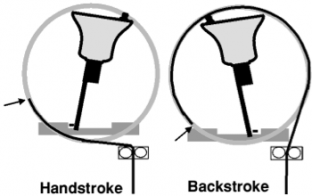Handling light bells
One of the 50 Ringing Things is to Ring on a bell lighter than 3 cwt (152 kg). My home tower is a six with the front three less than 3 cwt, so we do get the occasional visitor who comes along to collect a thing.
What do I tell them before they catch hold?
There is one component of a bell mechanism which doesn’t weigh ever so much, but the weight of which starts to matter more and more as the weight of the bell gets less and less. This is because the weight of this bit doesn’t reduce much as we go from a heavy bell to a lighter one. Perhaps surprisingly, this is the rope itself!
Think about what happens to the rope as we ring a bell. The image (right) may help you to visualise it. When you pull the sally at handstroke the wheel turns and the rope comes down, then it goes back up and is wound right around the wheel ready for the backstroke. But, because the sally has risen to a higher point now, more rope is wound onto the wheel than before – and you need to have provided enough energy to add to the momentum of the bell to get all that rope up there. With a light bell there isn’t much momentum, so you have to pull the handstroke relatively firmly to get the rope to do that. At backstroke, however, the weight of the rope itself will help you to turn the bell, and the additional energy this provides will easily lift the shorter length of rope back up again. If you’re ringing in a tower with a long draught the effect is even more obvious because a longer rope weighs more.
So here are some things to think about:
- Try to feel the point of balance, even though it’s less obvious than with a heavier bell
- At handstroke you will probably have to pull quite a bit more firmly than you expect, but start gently as you don’t want to endanger the stay
- Keep tension in the rope at backstroke, but try not to add any more energy – it probably won’t be needed
- Keep your arms high at both handstroke and backstroke, and accurately adjust the rope length, so as not to bump the stay
Another time when a difference is obvious is when raising or lowering a light bell in peal. When raising, it’s very easy to go up far too quickly, and lowering often catches people out because heavy bells have enough momentum to stay up without much work from the ringer. Whereas with a light bell you really have to work to keep the bell far enough up even as it’s coming down – you’ll probably find that you need to add energy at every stroke, even when you’re ringing one-handed. It also helps if you can make or release coils without thinking, so you can concentrate on accurately following the bell in front of you on every stroke.
One final point: one of the other things is to Ring on a Mini Ring with a tenor less than 1 cwt or 50 kg. What I’ve said here doesn’t really apply to a mini ring because they are engineered differently, so if you want to collect that thing as well you’ll need to seek further advice before you have a go at that.
When we asked John Harrison for permission to use his image, he suggested also reading the article Does size matter? from The Ringing World, available at cccbr.org.uk/wp-content/uploads/2016/02/200205.pdf.

Mike Rigby, ART Teacher and Tower Captain at Lighthorne, Warks